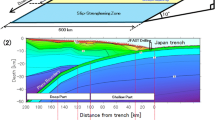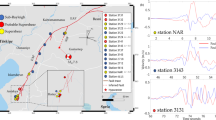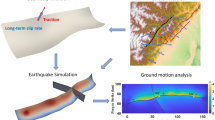Abstract
The Korean Peninsula is located in a low-seismicity zone at the eastern margin of the Eurasian plate. However, the 2016 Gyeongju and 2017 Pohang earthquakes, which occurred in southeastern Korea, highlight the importance of advanced seismic hazard assessment and mitigation in this region. We successfully performed spontaneous dynamic rupture modeling by considering the crustal stress field in southeastern Korea, constrained by earthquake focal mechanism data, to better understand the seismic hazard in the region. We found that the geologically recognized Yangsan fault trace near the location of the Gyeongju earthquake is not aligned well with the favorable shear rupture directions, given the current crustal stress field in the region. The fault needs to be very weak (i.e., have a low static friction coefficient) to initiate a large earthquake rupture. However, our dynamic model results show that the fault plane constrained by the focal mechanism solution of the 2016 Gyeongju earthquake is more favorably aligned for shear rupture under the current stress condition and that it may be able to produce a relatively large earthquake if the extension of the fault is quite long (~60 km). This type of dynamic rupture modeling study may help to more accurately elucidate the seismic hazard in a low-seismicity zone such as southeastern Korea.
Similar content being viewed by others
References
Allmann, B.P. and Shearer, P.M., 2009, Global variations of stress drop for moderate to large earthquakes. Journal of Geophysical Research, 114, B01310.
Andrews, D.J., 1976, Rupture velocity of plane strain shear cracks. Journal of Geophysical Research, 81, 5679–5687.
Brace, W.F. and Kohlstedt, D.L., 1980, Limits on lithospheric stress imposed by laboratory experiments. Journal of Geophysical Research, 85, 6248–6252.
Causse, M. and Song, S.G., 2015, Are stress drop and rupture velocity of earthquakes independent? Insight from observed ground motion variability. Geophysical Research Letters, 42, 7383–7389.
Causse, M., Dalguer, L.A., and Mai, P.M., 2014, Variability of dynamic source parameters inferred from kinematic models of past earthquakes. Geophysical Journal International, 196, 1754–1769.
Choi, H., Hong, T.-K., He, X., and Baag, C.-E., 2012, Seismic evidence for reverse activation of a paleo-rifting system in the east sea (sea of Japan). Tectonophysics, 572–573, 123–133.
Chwae, U.C., Kim, K.B., Hong, S.H., Lee, B.J., Hwang, J.H., Park, K.H., Hwang, S.K., Choi, P.Y., Song, K.Y., and Jin, M.S., 1995, Geological Map of Korea (Scale 1:1,000,000). Korea Institute of Geoscience and Mineral Resources, Daejeon, South Korea.
Dalguer, L.A. and Day, S.M., 2007, Staggered-grid split-node method for spontaneous rupture simulation. Journal of Geophysical Research, 112, B02302.
Dalguer, L.A. and Mai, P.M., 2011, Near-source ground motion variability from M = 6.5 dynamic rupture simulations. 4th IASPEI/IAEE International Symposium on Effects of Surface Geology on Strong Ground Motion (Expanded Abstract), Santa Barbara, Aug. 23–26.
Day, S.M., 1982, Three-dimensional simulation of spontaneous rupture: the effect of nonuniform prestress. Bulletin of the Seismological Society of America, 72, 1881–1902.
Day, S.M., Dalguer, L.A., Lapusta, N., and Liu, Y., 2005, Comparison of finite difference and boundary integral solutions to three-dimensional spontaneous rupture. Journal of Geophysical Research, 110, B12307.
Ely, G.P., Day, S.M., and Minster, J.-B., 2009, A support-operator method for 3-D rupture dynamics. Geophysical Journal International, 177, 1140–1150.
Grigoli, F., Cesca, S., Rinaldi, A.P., Maconi, A., Lopez-Comino, J.A., Clinton, J.F., Westaway, R., Cauzzi, C., Dahm, T., and Wiemer, S., 2018, The November 2017 MW 5.5 Pohang earthquake: a possible case of induced seismicity in South Korea. Science, 360, 1003–1006.
Harris, R.A., Barall, M., Archuleta, R., Dunham, E., Aagaard, B.T., Ampuero, J.P., Bhat, H., Cruz-Atienza, V.M., Dalguer, L., Dawson, P., Day, S., Duan, B., Ely, G., Kaneko, Y., Kase, Y., Lapusta, N., Liu, Y., Ma, S., Oglesby, D., Olsen, K., Pitarka, A., Song, S., and Templeton, E., 2009, The SCEC/USGS dynamic earthquake rupture code verification exercise. Seismological Research Letters, 80, 119–126.
Houng, S.E. and Hong, T.K., 2013, Probabilistic analysis of the Korean historical earthquake records. Bulletin of the Seismological Society of America, 103, 2782–2796.
Kanamori, H. and Anderson, D.L., 1975, Theoretical basis of some empirical relations in seismology. Bulletin of the Seismological Society of America, 65, 1073–1095.
Kim, K.-H., Kim, J., Han, M., Kang, S.Y., Son, M., Kang, T.-S., Rhie, J., Kim, Y., Park, Y., Kim, H.-J., You, Q., and Hao, T., 2017, Deep fault plane revealed by high-precision locations of early aftershocks following the 12 September 2016 ML 5.8 Gyeongju, Korea, earthquake. Bulletin of the Seismological Society of America, 108, 517–523.
Kim, K.-H., Ree, J.-H., Kim, Y., Kim, S., Kang, S.Y., and Seo, W., 2018, Assessing whether the 2017 MW 5.4 Pohang earthquake in South Korea was an induced event. Science, 360, 1007–1009.
Kim, S., Rhie, J., and Kim, G., 2011, Forward waveform modelling procedure for 1-D crustal velocity structure and its application to the southern Korean Peninsula. Geophysical Journal International, 185, 453–468.
Kim, Y., Rhie, J., Kang, T.-S., Kim, M., and Lee, S.-J., 2016, The 12 September 2016 Gyeongju earthquakes: 1. Observation and remaining questions. Geosciences Journal, 20, 747–752.
Kohlstedt, D.L., Evans, B., and Mackwell, S.J., 1995, Strength of the lithosphere: constraints imposed by laboratory experiments. Journal of Geophysical Research, 100, 17587–17602.
Kyung, J., 2010, Paleoseismological study and evaluation of maximum earthquake magnitude along the Yangsan and Ulsan fault zones in the southeastern part of Korea. Geophysics and Geophysical Exploration, 13, 187–197.
Kyung, J.B., Lee, K., and Okada, A., 1999, A paleoseismological study of the Yangsan fault — analysis of deformed topography and trench survey. Journal of the Korean Geophysical Society, 2, 155–168.
Lee, K., 2017, Discussions on the september 2016 Gyeongju earthquakes. Geophysics and Geophysical Exploration, 20, 185–192.
Lee, K. and Na, S.H., 1983, A study of microearthquake activity of the Yangsan fault. Journal of the Geological Society of Korea, 19, 127–135.
Lee, K. and Song, S.G., 2016, A preliminary study on the Gyeongju earthquakes in September 2016. Journal of National Academy of Sciences, Republic of Korea, 55, 25–39.
Lee, K. and Yang, W.-S., 2006, Historical seismicity of Korea. Bulletin of the Seismological Society of America, 96, 846–855.
Machette, M.N., Personius, S., Nelson, A., Schwartz, D.P., and Lund, W.R., 1991, The Wasatch faut zone, Utah-segmentation and history of Holocene earthquakes. Journal of Structural Geology, 13, 137–149.
Manighetti, I., Campillo, M., Bouley, S., and Cotton, F., 2007, Earthquake scaling, fault segmentation, and structural maturity. Earth and Planetary Science Letters, 253, 429–438.
Moeck, I., Kwiatek, G., and Zimmermann, G., 2009, Slip tendency analysis, fault reactivation potential and induced seismicity in a deep geothermal reservoir. Journal of Structural Geology, 31, 1174–1182.
Numelin, T., Marone, C., and Kirby, E., 2007, Frictional properties of natural fault gouge from a low-angle normal fault, Panamint Valley, California. Tectonics, 26, TC2004.
Olsen, K., Madariaga, R., and Archuleta, R.J., 1997, Three-dimensional dynamic simulation of the 1992 landers earthquake. Science, 278, 834–838.
Pitarka, A., Dalguer, L.A., Day, S.M., Somerville, P.G., and Dan, K., 2009, Numerical study of ground-motion differences between buried-rupturing and surface-rupturing earthquakes. Bulletin of the Seismological Society of America, 99, 1521–1537.
Rhee, H.M. and Sheen, D.H., 2016, Lateral variation in the source parameters of earthquakes in the Korean Peninsula. Bulletin of the Seismological Society of America, 106, 2266–2274.
Saffer, D.M. and Marone, C., 2003, Comparison of smectite- and illiterich gouge frictional properties: application to the updip limit of the seismogenic zone along subduction megathrusts. Earth and Planetary Science Letters, 215, 219–235.
Soh, I., Chang, C., Lee, J., Hong, T.-K., and Park, E.-S., 2018, Tectonic stress orientations and magnitudes, and friction of faults, deduced from earthquake focal mechanism inversions over the Korean Peninsula. Geophysical Journal International, 213, 1360–1373.
Son, M., Cho, C.S., Shin, J.S., Rhee, H.M., and Sheen, D.H., 2017, Spatiotemporal distribution of events during the first three months of the 2016 Gyeongju, Korea, earthquake sequence. Bulletin of the Seismological Society of America, 108, 210–217.
Song, S.G. and Dalguer, L.A., 2013, Importance of 1-point statistics in earthquake source modelling for ground motion simulation. Geophysical Journal International, 192, 1255–1270.
Song, S.G. and Lee, H., 2019, Static slip model of the 2017 Mw 5.4 Pohang, South Korea, earthquake constrained by the InSAR data. Seismological Research Letters, 90, 140–148.
Tinti, E., Spudich, P., and Cocco, M., 2005, Earthquake fracture energy inferred from kinematic rupture models on extended faults. Journal of Geophysical Research, 110, B12303.
Uchide, T. and Song, S.G., 2018, Fault rupture model of the 2016 Gyeongju, South Korea, earthquake and its implication for the underground fault system. Geophysical Research Letters, 45, 2257–2264.
Verberne, B.A., He, C., and Spiers, C.J., 2010, Frictional properties of sedimentary rocks and natural fault gouge from the Longmen Shan fault zone, Sichuan, China. Bulletin of the Seismological Society of America, 100, 2767–2790.
Wells, D.L. and Coppersmith, K.J., 1994, New empirical relationships among magnitude, rupture length, rupture width, rupture area, and surface displacement. Bulletin of the Seismological Society of America, 84, 974–1002.
Woo, J.-U., Rhie, J., Kim, S., Kang, T.-S., Kim, K.-H., and Kim, Y., 2019, The 2016 Gyeongju earthquake sequence revisited: aftershock interactions within a complex fault system. Geophysical Journal International, 217, 58–74.
Zoback, M.D. and Townend, J., 2001, Implications of hydrostatic pore pressures and high crustal strength for the deformation of intraplate lithosphere. Tectonophysics, 336, 19–30.
Acknowledgments
We would like to thank two anonymous reviewers and the editor for their thoughtful review comments, which helped to improve our manuscript significantly. This work was supported by the Basic Research Project (GP2020-027) of KIGAM (Korea Institute of Geoscience and Mineral Resources), funded by the Korean government (MSIT: Ministry of Science and ICT), and the National Research Foundation of Korea (NRF) grant (No. NRF-2018R1A4A1059956), funded by the Korea government (MSIT).
Author information
Authors and Affiliations
Corresponding author
Additional information
Publisher’s Note Springer Nature remains neutral with regard to jurisdictional claims in published maps and institutional affiliations.
Rights and permissions
About this article
Cite this article
Song, S.G., Chang, C. Dynamic earthquake rupture modeling considering regional crustal stress conditions in southeastern Korea. Geosci J 25, 211–222 (2021). https://doi.org/10.1007/s12303-020-0015-x
Received:
Accepted:
Published:
Issue Date:
DOI: https://doi.org/10.1007/s12303-020-0015-x




